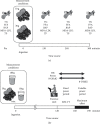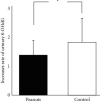Ingestion of High-Oleic Peanut Improves Endurance Performance in Healthy Individuals
- PMID: 35310027
- PMCID: PMC8930216
- DOI: 10.1155/2022/3757395
Ingestion of High-Oleic Peanut Improves Endurance Performance in Healthy Individuals
Abstract
This study aimed at evaluating whether high-oleic peanuts (with skin), which are rich in oleic acid, could serve as an energy substrate for prolonged exercise and improve endurance performance. We evaluated changes in blood biomarker (triglycerides, free fatty acid (FFA), biological antioxidant potential (BAP), malondialdehyde-modified low-density lipoprotein (MDA-LDL), and serum total protein) levels at 2-h intervals for 6 h after the ingestion of 10 g and 30 g of peanuts. The results were used to determine the timing of peanut ingestion before the endurance performance test. As a result, there was a significant change in the 30-g peanut-ingested condition, and lipid levels increased 2 h after the ingestion of 30 g of peanuts. Accordingly, the endurance performance test was conducted 2 h after ingesting 30 g of peanuts. The endurance performance test involved 70 min of pedaling exercise. We measured pre- and postexercise levels of 8-hydroxy-2'-deoxyguanosine (8-OHdG), which is a biomarker of oxidative stress. There was a significantly improved workload in the endurance performance test in the high-oleic peanut-ingested condition than in the control condition. Furthermore, the rate of increase in 8-OHdG was significantly lower in the high-oleic peanut-ingested condition than in the control condition. This suggests that the increase in FFA levels resulting from the ingestion of high-oleic peanuts and the inherent antioxidant effects of peanuts improved the workload during endurance exercise.
Copyright © 2022 Morimasa Kato et al.
Conflict of interest statement
This study was supported financially by Denroku Co Ltd. Daisuke Kurata is a Denroku Co Ltd. employee.
Figures





Similar articles
-
Sensory and Chemical Stabilities of High-Oleic and Normal-Oleic Peanuts in Shell During Long-Term Storage.J Food Sci. 2018 Sep;83(9):2362-2368. doi: 10.1111/1750-3841.14295. Epub 2018 Aug 3. J Food Sci. 2018. PMID: 30074611
-
Feeding high-oleic peanuts to layer hens enhances egg yolk color and oleic fatty acid content in shell eggs.Poult Sci. 2019 Apr 1;98(4):1732-1748. doi: 10.3382/ps/pey531. Poult Sci. 2019. PMID: 30535420
-
High-oleic peanuts are not different from normal peanuts in allergenic properties.J Agric Food Chem. 2002 Feb 13;50(4):878-82. doi: 10.1021/jf011132u. J Agric Food Chem. 2002. PMID: 11829661
-
The use of carbohydrates during exercise as an ergogenic aid.Sports Med. 2013 Nov;43(11):1139-55. doi: 10.1007/s40279-013-0079-0. Sports Med. 2013. PMID: 23846824 Review.
-
A review of the nutritional composition, organoleptic characteristics and biological effects of the high oleic peanut.Int J Food Sci Nutr. 2014 Nov;65(7):781-90. doi: 10.3109/09637486.2014.937799. Epub 2014 Jul 14. Int J Food Sci Nutr. 2014. PMID: 25017702 Review.
Cited by
-
Polyphenol-Rich Snack Consumption during Endurance Exercise Training Improves Nitric Oxide Bioavailability but does not Improve Exercise Performance in Male Cyclists: A Randomised Controlled Trial.Curr Dev Nutr. 2025 Mar 24;9(5):106006. doi: 10.1016/j.cdnut.2025.106006. eCollection 2025 May. Curr Dev Nutr. 2025. PMID: 40321836 Free PMC article.
References
-
- Weiss B. A., Powers M. E. Creatine supplementation does not impair the thermoregulatory response during a bout of exercise in the heat. The Journal of Sports Medicine and Physical Fitness . 2006;46(4):555–563. - PubMed
LinkOut - more resources
Full Text Sources
Research Materials

